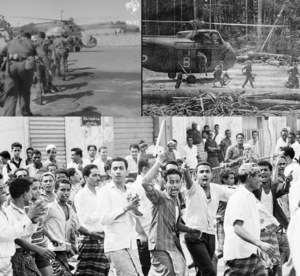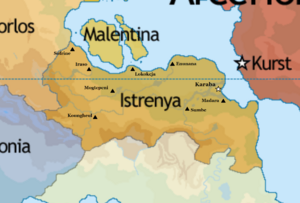Istrenyan Crisis
 (Clockwise from top left) Members of 7 Rifle Brigade's Royal Moorden Regiment are extracted from Eastern Istrenya via helicopter; Arcer Army service members are dropped off near the Line of Contact (LOC) to conduct stabilisation operations; Indigenous protestors clash with Instrenyan National Policemen in the capitol during the 1959 Riots. | |
| Duration | 1959-1961; 3 years |
|---|---|
| Also known as | Istrenyan Crisis; First Istrenyan Civil War; Malentine Crisis |
| Type | Civil War |
| Cause | Communist and Popular Uprising |
| Participants | Arcerion Istrenya Various Insurgent/Political Groups |
| Outcome | Status quo; Communist Revolt suppressed, Indigenous Populist Government maintains power. |
The 1959 Istrenyan Civil Crisis, also known as the First Istrenyan Civil War or the Malentine Crisis was an armed rebellion by the National Instrenyan People's Front (NIPF) during the 20th century between 1959-1961 in the Southern Cronan nation of Istrenya.
Inspired by other socialist movements during the same decade, it began in April 1959 when a pair of Arcer diplomatic officials were assaulted by a mob, angered over recent increases in tariffs on Istrenyan agricultural exports to the Occidental nation. Heavy-handed responses by the national police and security forces led to more civilian and military deaths, as well as a continued escalation in the riots. Formal complaints by the Arcer government to the Istrenyan President's office resulted in a severe scalation in 1960, and with continued attacks on Occidentals, the Arcer government formally issued a notice to the Istrenyan government that it would conduct a military intervention to stabilise the situation.
By 1961, the crisis had stabilized, and the Arcer government was able to close its embassy and consulates in Istrenya, as well as withdraw the joint military task force it had deployed to the region. In the crisis' wake, the Istrenyan government managed to remain in power with assistance from the Office of Public Safety and National Security.
Background
Istrenya was never under direct colonial rule from any Levantine or Sarpedonian nations, however mercantile influence had often relegated it to inconsistent economic growth and recurring bouts of recession and economic strife. Traditionally the maritime economy Istrenya enjoyed was primarily based on fishing, simple agriculture, and raw mineral and natural resource extraction, however with the expansion of modern Occidental corporations in the 19th and 20th centuries, these companies grew to inherit large amounts of influence over the Istrenyan government. Most prominent amongst these were corporations from Arcerion, located directly across from Istrenya across the Warrington Strait and Malentine Sea. Following the end of the Second Great War and the rise of decolonization amongst many smaller Indigenous nations and their colonies, Istrenya saw a rise of socialist and liberal movements aimed at toppling the existing Populist government under President A'kale Treo.
Increased activity amongst Indigenous peoples promoting Indigenous Nationalism had spread from Varshan into South Crona, with similar movements occurring in Porlos and Kelekona. During the Second Great War, Indigenous nations reinforced their neutral positions by refusing to allow many warships and airplanes from Arcerion and other Allied nations from using their facilities. It was assessed that communist and syndicalist sympathizers, foreign fighters, and ideological radicals from other Indigenous nations moved to Istrenya anticipating a much larger conflict, however the limited political success in the 1958 Istrenyan Elections meant that there was a limited perceived legitimate political base for liberal and socialist thought, and the majority of the dissidents were native Istrenyans.
Crisis

In April of 1959, two Arcer diplomatic officials were out in the large Southern Istrenyan town of Madara, John Francis (Deputy Ambassador) and Nathan Phillips (Head of Development, Istrenya), were having dinner at the Hotel Chekila, an Occidental-owned establishment frequented by members of the Levantine and Southern Cronan elite. Several disenfranchised members of a local farmer's union, frustrated at their protest over tariff increases were frustrated by the police breaking up their strike, and on their walk home encountered Francis and Phillips having dinner on the hotel's outdoor street patio. After a short verbal altercation, Francis and Phillips were violently attacked and beaten, suffering serious injuries that had both in the hospital in critical condition for weeks.
A formal protest was lodged by the Arcer ambassador within twenty four hours, and as a result President Treo cracked down using the Istrenyan National Police. The police broke up multiple union meetings and protests, including several that had the correct permits and permissions. The end result was a massive wave of bad publicity and news articles for the Presidential office, including numerous new protests and open street riots against the police slowly escalating in size and damages to public and private property.